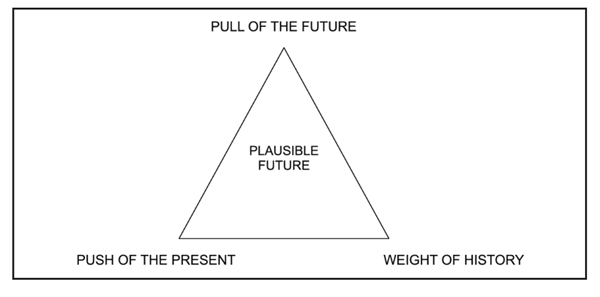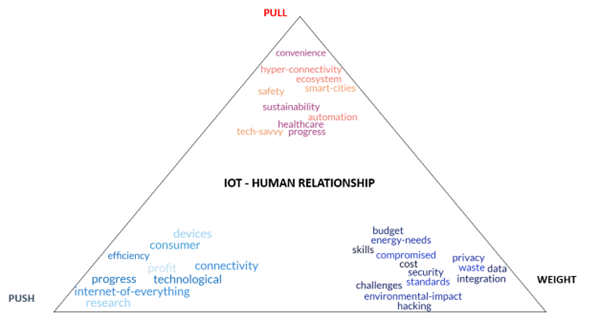Introduction
Over the past 25 years, our lives have become intertwined with technology, enabling us to be more connected. Connected to the internet, interacting with appliances, phones and sensors aimed to make our lives easier. These make up the “Internet of Things (IoT)”, a term coined in 1999. According to IBM it “refers to a network of physical devices, vehicles, appliances, and other objects embedded with sensors, software, and connectivity capabilities that allows them to collect and share data” over the internet. As well as the passive activities of collecting and sharing data, IoT devices are also capable of acting through actuators and changing their behaviour.
As IoT devices have become an integral part of our lives, to fully understand the potential but also risks they carry, we must look ahead using foresight methods. These methods include examining future socio-technical trends to anticipate the potential impacts and develop strategic responses and actions.
The Mission of Foresight
Foresight is a strategic, and proactive, process that involves exploring various future possibilities and assessing their implications to inform present-day decisions and strategies. It is important as it helps individuals, organisations, and governments navigate uncertainty and complexity, enabling them to make proactive choices, from mitigating risks to exploiting opportunities, and adapt resiliently to ever-changing circumstances effectively.
The Futures Triangle and why it is important
The Futures triangle is a conceptual framework that was created by Prof Sohail Inayatullah. This foresight methodology helps explain any topic, often emerging or existing technologies, and by exploring the interplay of three key elements (composing the triangle), it maps their influence on shaping a possible future.

Inallatuyah Futures triangle – source: Prof Inallatuyah (2007), Six pillars: futures thinking for transforming 102166 4..21 (benlandau.com) (page 8)
The three angles of the triangle represent:
The pull of the future: a vision of the future, a driving force bringing, for example, a niche technology to the mainstream.
The push of the present: the driving forces of the present that affect the future.
The weight of history: the barriers to change, from cultural tradition to environmental reasons.
With this method, we can analyse the conflicting forces in the present between the push and barriers to change. The brainstorming and mapping activity allows us to create scenarios of possible futures from the variables and to see the preferred future – and the path forward.
Application to IoT
In 2030, it is expected there will be over 24 billion IoT devices worldwide2, a 160% increase compared to 2020. The interconnection via the internet of computing devices embedded in everyday objects has already spurred a revolution in how businesses and consumers interact with the world.
Yet, as IoT technology is expected to become even more prevalent, virtually everything could soon be connected to the internet. For example, sensors embedded in walls and furniture will detect changes and alert owners when repairs or maintenance is needed. Smart appliances will monitor energy usage and automate chores, while connected cars will allow for remote diagnostics and real-time traffic updates.
And these are just a few potential applications of IoT –the possibilities are virtually endless. In the coming years, this powerful technology has the potential to help us solve many of the world’s biggest problems – from climate change to traffic congestion to healthcare. But it also comes with risks.
Let us consider what a Futures triangle of IoT might look like:
(Click the image for more detail)
From this brainstorming in the Futures triangle, we can see that the Pull of the future is to have an IoT ecosystem that harnesses progress and automation, enhances healthcare and convenience while enabling sustainability. The push in the present is through cutting-edge research on the sensors, devices and connectivity that enable a world of the “internet of everything” to help us achieve the vision of the future. There are however barriers to this future of IoT in the raise of attack surfaces and hacking with the expansion of IoT sensors and devices, the environmental impact of the sheer number of cheap IoT devices, and privacy considerations.
Now that we have brainstormed the different elements at play concerning IoT, let us consider three types of future brought forth by the variables described:
The Most Likely Future of IoT: A Hyperconnected World
The most likely future of IoT is one of hyperconnectivity. As the present trajectory of IoT adoption continues, we can expect a seamless integration of everyday objects, environments, and even people into a vast digital network. A world where smart homes, smart cities, and smart industries are the norm. In this future, where 5G networks and beyond will be the backbone of IoT infrastructure, the devices will pervade our lives to an extent where they become nearly invisible, operating in the background to enhance convenience, efficiency, and personalization. Quantum Communications, as being explored by Imperial Centre for Quantum Engineering, Science and Technology will add new speed and security capabilities.
Imagine waking up in a smart home where your alarm clock triggers your coffee maker and opens your blinds based on the time of day and your personal preferences. As you step outside, the city’s infrastructure anticipates your needs – traffic lights adjust to optimize traffic flow, garbage bins signal when they need to be emptied, and public transportation routes adapt to real-time demand. These cities will be the epitome of connectivity, where IoT sensors and devices will work harmoniously to allow citizens to enjoy enhanced safety, convenience, and sustainability in their daily lives.
The Most Preferable Future: A Harmonious Ecosystem of IoT
In the most preferable future, IoT evolves into a harmonious ecosystem that balances technological advancement with ethical considerations and human well-being. This future is marked by collaboration between industries, governments, and individuals to create a world where IoT technologies amplify human potential and address pressing global challenges.
One area where the potential of IoT is expected to have a profound positive impact is sustainability. IoT-powered smart grids and energy management systems will optimize energy consumption, reduce waste, and promote the integration of renewable energy sources. This green approach will be crucial in mitigating climate change and ensuring a sustainable future for generations to come. More efforts have to be made in this scenario to develop energy-efficient and eco-friendly IoT technologies to reduce their carbon footprint as well as proper disposal and recycling solutions.
In this harmonious IoT ecosystem, environmental sensors work tirelessly to monitor air and water quality, alerting authorities and communities to potential risks. Healthcare devices seamlessly transmit vital data to medical professionals, enabling early intervention and personalized treatment plans. Current research in smart medical devices forecasts solutions and aids to continuously monitor patients’ health, providing real-time data to healthcare professionals. Agricultural IoT systems optimize crop yields while minimizing resource usage, contributing to sustainable food production.
The Most Avoidable Future: Navigating Ethical and Security Pitfalls
While the possibilities of a hyperconnected world are thrilling, the most avoidable future points to potential ethical and security pitfalls. And the anticipated tripling of IoT devices in the next 7 years will generate data to unprecedented levels – for reference, a forecast already of almost 80 zettabytes by 2025.
Therefore, we can easily anticipate that advanced data analytics tools, such as edge computing and distributed ledger technologies, will become instrumental in processing data in a decentralised way. This approach reduces latency, enhances privacy, and lowers the burden on cloud infrastructure. Businesses will harness this information to optimize processes, reduce costs, and enhance customer experiences.
But the devices’ extensive capabilities to collect private data automatically through IoT devices could also have social implications such as increased surveillance, loss of anonymity, and potential discrimination based on collected data.
In this scenario, rapid IoT adoption outpaces our ability to regulate and secure these technologies adequately. This could lead to a world where privacy breaches, data misuse, and systemic vulnerabilities become rampant.
Consider a future where personal data collected by IoT devices is exploited for profit without user consent, leading to widespread mistrust and a fractured digital society. Critical infrastructure controlled by IoT systems could become targets for cyberattacks, disrupting entire cities or industries. Balancing the convenience of IoT with robust security measures and ethical considerations is essential to avoid this dystopian path. It is therefore important to highlight and address ethical dilemmas associated with technology. Questions surrounding data ownership, consent, and the potential for discrimination in AI algorithms must be carefully navigated to ensure a fair and just IoT ecosystem.
Navigating the Futures Triangle for a Balanced IoT Future
So, how can we navigate the Futures Triangle to ensure a balanced future for IoT? The key lies in proactive decision-making and a multidimensional approach to shaping technology’s trajectory.
Envisioning Preferred Futures: Embracing the most preferable future requires collaboration among stakeholders. Industry leaders, policymakers, ethicists, and technologists must work together to set ethical standards, design secure systems, and prioritize human well-being. Establishing regulatory frameworks that protect user data and privacy while fostering innovation will be critical.
Mitigating Avoidable Futures: To avoid the pitfalls of IoT, investing in cybersecurity is paramount. Continuous research, threat modelling, and incorporating security-by-design principles into IoT devices will help mitigate risks. Such research is done in Imperial College with research themes spanning from sensing platforms, self-configuration and security as in the work of Prof Emil Lupu, seamless integration and wearable sensors as in the work of Prof Julie McCann or even big data. We also two centres, RITICS and ISST who focus on security and cyber-physical systems. Moreover, cultivating a culture of digital literacy and responsible IoT usage among consumers will empower individuals to protect their data and privacy.
Anticipating Likely Futures: Understanding the trajectory of IoT’s evolution is crucial for preparedness. As IoT becomes more integrated into our lives, adapting education and training programs to equip individuals with the skills needed to harness these technologies effectively will be vital. Additionally, developing adaptable regulatory frameworks that can keep pace with technological advancements will ensure that IoT evolves responsibly.
Conclusion
In conclusion, the Futures Triangle Theory offers a profound lens through which to examine the future of IoT with a human-centric angle. By considering the different scenarios from the conflicting influences in the futures triangle, we can shape a future that harnesses the potential of IoT while safeguarding against its pitfalls. Embracing collaboration, ethical considerations, and proactive security measures will enable us to create a hyperconnected world that enhances human lives, fosters sustainability, and upholds our core values. The journey to this future begins with our actions today, guided by the insights provided by the Futures Triangle Theory.
Enabling the IoT at Imperial
Imperial College London has many technology initiatives but one that captures this issue well is the start-up Sensor coatings. It is looking at Innovative sensor solutions for harsh environments.
Elsewhere, check out DNA electronics a spinout from our ecosystem that is creating a suite of electronic microchip-based solutions to enable faster, simpler and more cost-effective DNA analysis
